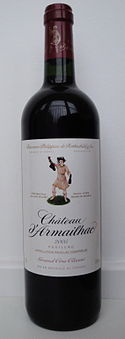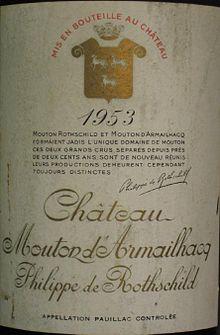Château d'Armailhac, previously named Château Mouton-d'Armailhacq (historical name from inception, 1750–1955), Château Mouton-Baron Philippe, Mouton Baronne and Château Mouton-Baronne-Philippe (1979–1988), is a winery in the Pauillac appellation of the Bordeaux region of France. The wine produced here was classified as one of eighteen Cinquièmes Crus (Fifth Growths) in the Bordeaux Wine Official Classification of 1855.[1] In 1989, Baroness Philippine decided to restore its original identity to Mouton d’Armailhacq, giving it the name Château d’Armailhac.[2]
The terroir
The Chateau has about 172 acres (70 hectares) planted with Cabernet Sauvignon (56%), Merlot (32%), Cabernet Franc (10%), and Petit Verdot (2%). Purchased by Baron Philippe de Rothschild in 1934, the estate is currently owned by the Mouton Rothschild branch of the Rothschild family.[3]
References
- ^ MacNeil, Karen (2001). The Wine Bible. Workman Publishing. pp. 885. ISBN 1-56305-434-5.
- ^ "Château d'Armailhac - History - 1989". Château d'Armailhac. Retrieved 2020-01-07.
- ^ J. Suckling, "50 Best Bordeaux under $50", Wine Spectator Magazine, p.69, March 31, 2007
External links

